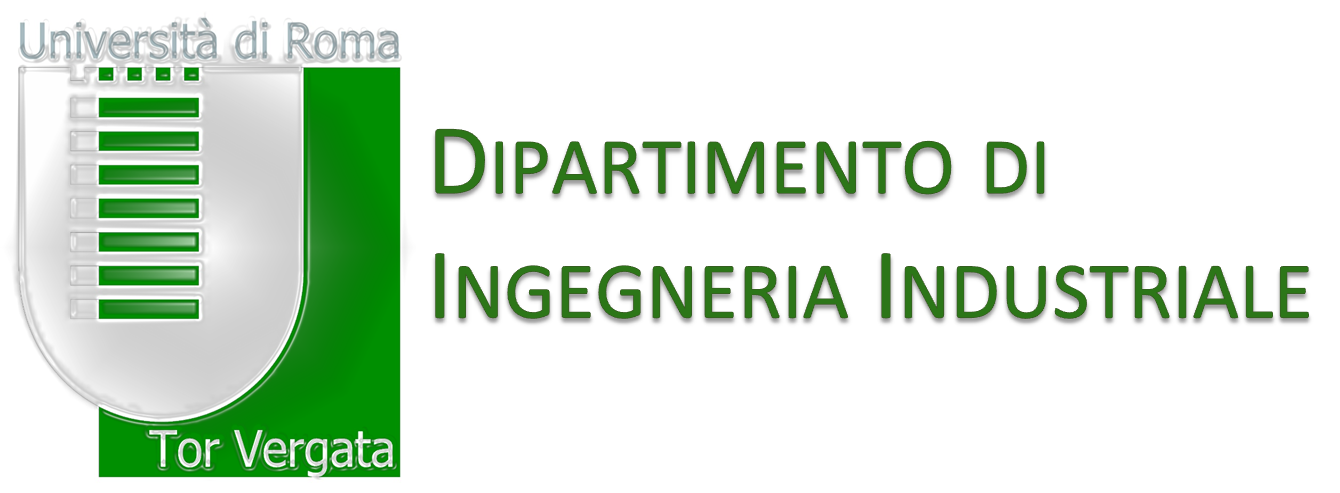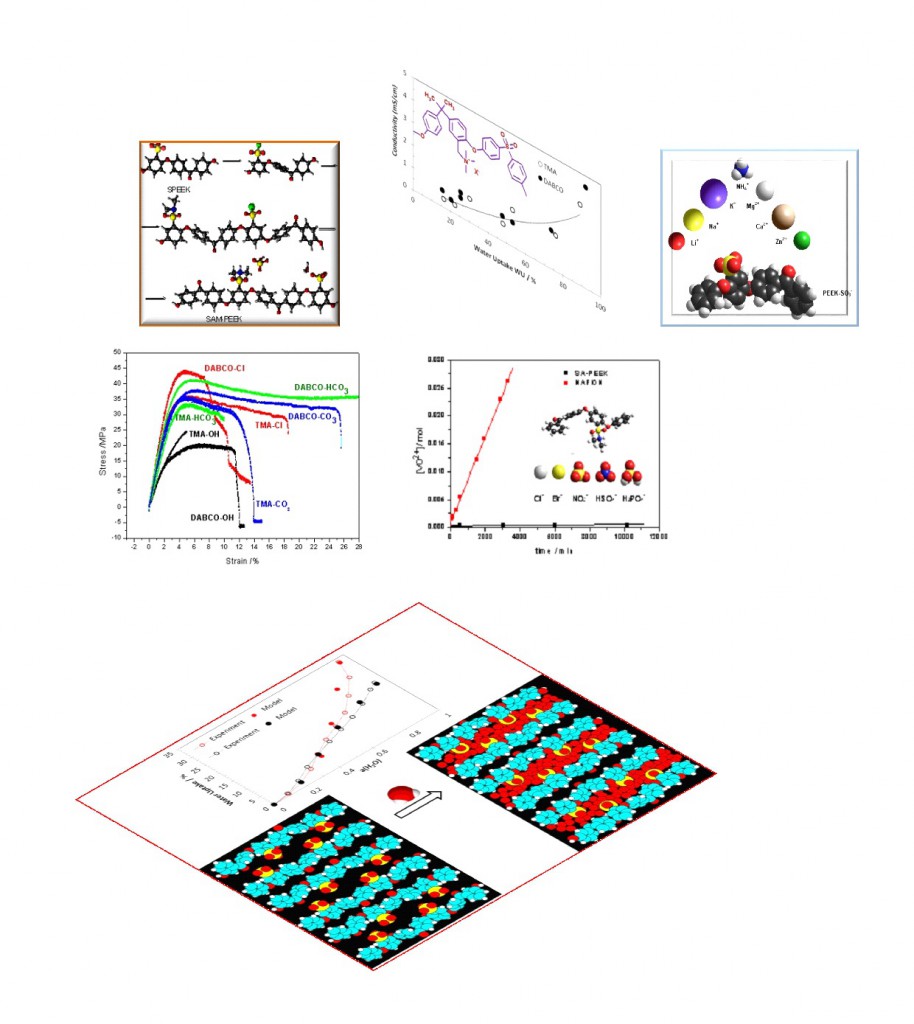
Partner istituzionali:
- Università degli Studi di Roma Tor Vergata
- Aix Marseille Università
- Centre National de la Recherche Scientifique
People:
- Principal Investigators: Maria Luisa Di Vona, Philippe Knauth
- PhD students: Michele Braglia, Ivan Vito Ferrari
- Current Collaborators: Roberto Montanari, Maria Richetta, Piergianni Medaglia, Thierry Djenizian, Florence Vacandio, Alessandra Varone
- Previous Collaborators: Pr. Hongying Hou, Dr. Jedeok Kim, Dr. Debora Marani, Dr. Emanuela Sgreccia, Dr. Riccardo Narducci, Dr. Luca Pasquini, Dr. M. Tamilvanan
Research:
The objective of the International Associated Laboratory “LIME” is to prepare and characterize ionomer materials for electrochemical energy technologies. Aromatic polymers are very attractive given their easy functionalization, low cost and easy recycling. Among the many aromatic polymers, we focus mainly on Poly(ether-ether-ketone) (PEEK), Poly(phenyl-sulfone) (PPSU), Polysulfone (PSU), and Poly(ether-sulfone) (PES).
- Proton conducting ionomers
Proton conducting ionomers are materials of choice for fuel cells and water electrolysis. The properties can be improved by innovative thermal treatments for annealing and cross-linking (XL-SPEEK) the macromolecules.
- Cation conducting ionomers
Various cations can be introduced by ion exchange or chemical reaction (e.g. with butyl-Li). The ionomers can be used as separators for rechargeable batteries (in anhydrous state) or for aqueous metal batteries.
- Hydroxide conducting ionomers
The most common ionomers contain quaternary ammonium groups. The basic operating conditions allow using non-noble electrocatalysts for the oxygen reduction reaction and thus an important cost reduction for alkaline fuel cells and water electrolysers.
- Anion conducting ionomers
They can be prepared by ion exchange from hydroxide conducting ionomers or by innovative synthesis by reaction of acids with basic groups (e.g. sulfonamides). Such ionomers are especially useful for redox flow batteries, where cation permeability must be minimized.
- Amphoteric ionomers
Acidic and basic groups coexist in a single macromolecule: the type and value of the ionic conductivity depends on the pH of its environment. This versatility and the low ionic permeability are very useful for technologies requiring low ion permeability.
Ionomer separators for electrochemical energy technologies are produced from the microscale (microbatteries based on TiO2 nanotubes) to the macroscale (redox flow batteries). The characterization techniques include spectroscopies (FTIR, UV and NMR), thermogravimetry, mechanical tests, permeability measurements, impedance spectroscopy and electrochemical measurements, such as cyclovoltammetry and galvanostatic polarization.
Publications
- M. L. Di Vona, D. Marani, C. D’Ottavi, M. Trombetta, E. Traversa, I. Beurroies, P. Knauth, S. Licoccia, A simple new route to covalent organic/inorganic hybrid proton exchange polymeric membranes, Chem. Mater., 18, 69-75 (2006).
- D. Marani, M. L. Di Vona, E. Traversa, S. Licoccia, I. Beurroies, P. L. Llewellyn, P. Knauth, Thermal stability and thermodynamic properties of hybrid proton conducting polyaryletherketones, J. Phys. Chem. B, 110, 15817-15823 (2006).
- M.L. Di Vona, D. Marani, A. D’Epifanio, S. Licoccia, I. Beurroies, R. Denoyel, P. Knauth, Hybrid materials for polymer electrolyte membrane fuel cells: Water uptake, mechanical and transport properties, J. Membrane Sci., 304, 76-81 (2007).
- E. Sgreccia, M. Khadhraoui, C. de Bonis, S. Licoccia, M.L. Di Vona, P. Knauth, Mechanical Properties of Hybrid Proton Conducting Polymer Blends Based on Sulfonated PolyEtherEtherKetones, J. Power Sources, 178, 667-670 (2008).
- M.L. Di Vona, S. Licoccia, P. Knauth, Organic–inorganic hybrid membranes based on sulfonated polyaryl–ether–ketones: Correlation between water uptake and electrical conductivity, Solid State Ionics, 179, 1161-1165 (2008).
- M. L. Di Vona, E. Sgreccia, S. Licoccia, M. Khadhraoui, R. Denoyel, P. Knauth, Composite Proton-Conducting Hybrid Polymers: Water Sorption Isotherms and Mechanical Properties of Blends of Sulfonated PEEK and Substituted PPSU, Chem. Mater., 20, 4327-4334 (2008).
- M. L. Di Vona, L. Luchetti, G. P. Spera, E. Sgreccia, P. Knauth, Synthetic strategies for the preparation of proton-conductinghybrid polymers based on PEEK and PPSU for PEM fuel cells, C. R. Chimie, 11, 1074-1081 (2008)
- M. L. Di Vona, E. Sgreccia, S. Licoccia, G. Alberti, L. Tortet, P. Knauth, Analysis of Temperature-Promoàted and Solvent-Assisted Cross-Linking in Sulfonated Poly(ether ether ketone) (SPEEK) Proton-Conducting Membranes, J. Phys. Chem. B, 113, 7505–7512 (2009).
- E. Sgreccia, M. L. Di Vona, S. Licoccia, M. Sganappa, M. Casciola, J. F. Chailan, P. Knauth, Self-assembled Nanocomposite Organic-Inorganic Proton Conducting SPEEK-based Membranes: Optimized Mechanical, Thermal and Electrical Properties, J. Power Sources, 192, 353-359 (2009).
- E. Sgreccia, J.-F. Chailan, M. Khadhraoui, M.L. Di Vona, P. Knauth, Mechanical properties of proton-conducting sulfonated aromatic polymer membranes: Stress–strain tests and dynamical analysis, J. Power Sources, 195, 7770-7775 (2010).
- P. Knauth, M. L. Di Vona, G. Alberti, Electrodes for PEM Fuel Cells, Fuel Cells, 10, 219 (2010).
- M.L. Di Vona, E. Sgreccia, M. Tamilvanan, M. Khadhraoui, C. Chassigneux, P. Knauth, High Ionic Exchange Capacity Polyphenylsulfone (SPPSU) and PolyEtherSulfone (SPES) Crosslinked by Annealing Treatment: Thermal Stability, Hydration Level and Mechanical Properties, J. Membrane Sci., 354, 134-141 (2010).
- M. L. Di Vona, P. Knauth, G. Alberti, Proton-conducting membranes for PEM fuel cells, J. Power Sources, 195, 7719-7719 (2010).
- P. Knauth, E. Sgreccia, A. Donnadio, M. Casciola, M. L. Di Vona, Water Activity Coefficient and Proton Mobility in Hydrated Acidic Polymers, J. Electrochem. Soc.,158, B159-165 (2011).
- M.L. Di Vona, E. Sgreccia, A. Donnadio, M. Casciola, J.F. Chailan, G. Auer, P. Knauth, Composite polymer electrolytes of sulfonated poly-ether-ether-ketone (SPEEK) with organically functionalized TiO2, J. Membrane Sci., 369, 536–544 (2011).
- E. Sgreccia, M. L. Di Vona, P. Knauth, Hybrid composite membranes based on SPEEK and functionalized PPSU for PEM fuel cells, Int. J. Hydrogen Energy, 36, 8063-8069 (2011).
- P. Knauth, H. Y. Hou, E. Bloch, E. Sgreccia, M. L. Di Vona, Thermogravimetric analysis of SPEEK membranes: Thermal stability, degree of sulfonation and cross-linking reaction, J. Anal. Appl. Pyrolysis, 92, 361-365 (2011).
- H. Y. Hou, M. L. Di Vona, P. Knauth, Durability of Sulfonated Aromatic Polymers for Proton-Exchange-Membrane Fuel Cells, ChemSusChem, 4, 1526-1536 (2011).
- S. Tosto, P. Knauth, M. L. Di Vona, Water adsorption/desorption in proton-conducting ionomer membranes: The model case of sulfonated and silylated poly-ether-ether-ketone, Solid State Ionics, 209-210, 9-14 (2012).
- M. L. Di Vona, G. Alberti, E. Sgreccia, M. Casciola, P. Knauth, High performance sulfonated aromatic ionomers by solvothermal macromolecular synthesis, International Journal of Hydrogen Energy, 37, 8672-8680 (2012).
- J. Hertz, M. L. Di Vona, P. Knauth, H. L. Tuller, Advanced Materials for Fuel Cells Introduction, Journal of Materials Research, 27, 1905-1905 (2012).
- H. Hou, B. Maranesi, J.-F. Chailan, M. Khadhraoui, R. Polini, M. L. Di Vona, P. Knauth, Crosslinked SPEEK membranes: Mechanical, thermal, and hydrothermal properties, Journal of Materials Research, 27, 1950-1957 (2012).
- P. Knauth, M. L. Di Vona, Sulfonated aromatic ionomers: Analysis of proton conductivity and proton mobility, Solid State Ionics, 225, 255-259 (2012).
- H. Hou, F. Vacandio, M.-L. Di Vona, P. Knauth, Sulfonated polyphenyl ether by electropolymerization. Electrochimica Acta, 81, 58-63 (2012).
- H. Hou, M. L. Di Vona, P. Knauth, Building Bridges: Crosslinking of Sulfonated Aromatic Polymers – a Review. Journal of Membrane Science, 423-424, 113-127 (2012).
- M. L. Di Vona, P. Knauth, Sulfonated Aromatic Polymers as Proton-Conducting Solid Electrolytes for Fuel Cells: a Short Review, Z. Phys. Chem., 227, 595-614 (2013).
- M. L. Di Vona, P. Knauth, J. Roziere, T. Norby, Solid Proton Conductors: Oxides and Polymers, Fuel Cells, 13, 4-5 (2013).
- P. Knauth, L. Pasquini, B. Maranesi, K. Pelzer, R. Polini, M. L. Di Vona, Proton Mobility in Sulfonated PolyEtherEtherKetone (SPEEK): Influence of Thermal Crosslinking and Annealing, Fuel Cells, 13, 79-85 (2013).
- H. Hou, R. Polini, M. L. Di Vona, X. X. Liu, E. Sgreccia, J. F. Chailan, P. Knauth, Thermal crosslinked and nanodiamond reinforced SPEEK composite membrane for PEMFC, International Journal Of Hydrogen Energy, 38, 3346-3351 (2013).
- B. Maranesi, H. Hou, R. Polini, E. Sgreccia, G. Alberti, R. Narducci, P. Knauth, M. L. Di Vona, Cross-Linking of Sulfonated Poly(ether ether ketone) by Thermal Treatment: How Does the Reaction Occur?, FUEL CELLS, 13, 107-117 (2013).
- H. Hou, F. Vacandio, M. L. Di Vona, P. Knauth, Electropolymerization of sulfonated phenol by cyclic voltammetry, Journal of Applied Polymer Science, 129, 1151-1156 (2013).
- M. L. Di Vona, L. Pasquini, R. Narducci, K. Pelzer, A. Donnadio, M. Casciola, P. Knauth, Cross-linked sulfonated aromatic ionomers via SO2 bridges: Conductivity properties, Journal Of Power Sources, 243, 488-493 (2013).
- P. Knauth, E. Sgreccia, M.L. Di Vona, Chemomechanics of acidic ionomers: Hydration isotherms and physical model, J. Power Sources, 267, 692-699 (2014).
- R. Narducci, M. L. Di Vona, P. Knauth, Cation-conducting ionomers made by ion exchange of sulfonated polyetheretherketone: Hydration, mechanical and thermal properties, and ionic conductivity, J. Membr. Sci., 465, 185-192 (2014).
- J. Doan, E. Kingston, I. Kendrick, K. Anderson, N. Dimakis, P. Knauth, M. L. Di Vona, E. Smotkin, Theoretical and experimental infrared spectra of hydrated and dehydrated sulfonated poly(ether ether ketone), Polymer, 55, 4671-4676 (2014).
- M.L. Di Vona, R. Narducci, L. Pasquini, K. Pelzer, P. Knauth, Anion-conducting ionomers: Study of type of functionalizing amine and macromolecular cross-linking, Int. J. Hydrogen Energy, 39, 14039-14049 (2014).
- N. Plylahan, S. Maria, T. N. T. Phan, M. Letiche, H. Martinez, C. Courreges, P. Knauth, T. Djenizian, Enhanced electrochemical performance of Lithium-ion batteries by conformal coating of polymer electrolyte, Nanoscale Research Letters, 9, Article Number: 544 (2014).
- L. Pasquini, P. Knauth, K. Pelzer, M. L. Di Vona, Anion-conducting sulfaminated aromatic polymers by acid functionalization, RSC Advances, 5, 56636-56644 (2015).
- L. Pasquini, F. Ziarelli, S. Viel, M. L. Di Vona and P. Knauth, Fluoride-ion-conducting Polymers: Ionic Conductivity and Fluoride Ion Diffusion Coefficient in Quaternized Polysulfones, ChemPhysChem, 16, 3631–3636 (2015).
- G. Barbieri, A. Brunetti, M. L. Di Vona, E. Sgreccia, P. Knauth, H. Y. Hou, R. Hempelmann, F. Arena, L. D. Beretta, B. Bauer, M. Schuster, J. O. Ossó, L. F. Vega, LoLiPEM: Long life proton exchange membrane fuel cells, International Journal of Hydrogen Energy, 41, 1921-1934 (2016).
- L. Pasquini, M. L. Di Vona, P. Knauth, Effects of anion substitution on hydration, ionic conductivity and mechanical properties of anion-exchange membranes, New Journal of Chemistry, 40, 3671-3676 (2016).
- R. Narducci, J.-F. Chailan, A. Fahs, L. Pasquini, M. L. Di Vona, P. Knauth, Mechanical Properties of Anion Exchange Membranes by Combination of Tensile Stress-Strain Tests and Dynamic Mechanical Analysis, Journal of Polymer Science Part B-Polymer Physics, 54, 1180-1187 (2016).

